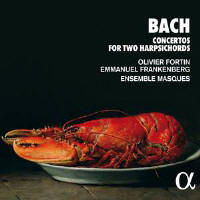Texte paru dans: / Appeared in: |
|
|
Appréciation d'ensemble / Overall evaluation :
|
|
|
Reviewer: Nicholas
Anderson The three Concertos for harpsichord and strings probably date from the early 1720s when Bach had recently become director of the partly student, partly professional Collegium Musicum at Leipzig. They may well have been included in the Collegiums concert programmes, perhaps featuring Bach's two elder sons as soloists. The two D minor Concertos are arrangements of earlier works for violin and oboe, BWV 1060, and for two violins, BWV 1062. The C major Concerto, BWV 1061, by contrast seems to be an entirely original work, almost certainly intended by Bach initially as a duo for two harpsichords without strings.
Olivier Fortin, Emmanuel
Frankenburg and Ensemble Masques give warm-blooded performances of the music.
Their approach is stylish in matters of ornament and articulation, and the
pervasive fugal content is argued clearly and authoritatively. Each concerto
possesses a notably lyrical middle movement and the poetry of each of these is
alluringly realised by all concerned. It is, though, the concluding movements
which are best of all. The musicians inject an infectious rhythmic energy into
them, white preserving a pellucid linear clarity which highlights those strands
of the score too often treated as mere filling.
The remaining item on
the menu is a translation for two solo harpsichords of the resplendent organ
Prelude and Fugue in E flat which frame the remaining contents of Part Three
(1739) of Bach’s Clavier-Übung. I found myself longing for the regal
radiance of an organ in the Prelude, but the five-part fugue is rewarding for
the light which the harpsichords shed on the counterpoint.
| |
|
|
|
|
|
|
|
Cliquez l'un ou l'autre
bouton pour découvrir bien d'autres critiques de CD |
|




